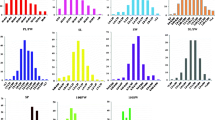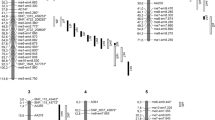Abstract
Three double low (erucic acid and glucosinolates) self-incompatible lines and 22 varieties from different origins were selected to produce 66 hybrids according to a NC II mating design. Field experiments for identification of hybrid performance and heterosis were conducted in two successive rapeseed growing seasons in Wuhan, China. After heterosis identifications, SI-1300 and Eagle were chosen to construct an F2 segregating population. One hundred and eighty four F2:3 lines were planted at Wuhan and Jingmen to test yield traits. F2 plants and the 25 parents were analyzed using simultaneously AFLP (amplified fragment length polymorphism) and SSR (simple sequence repeat) markers. A total of 270 and 718 polymorphic loci were detected in the F2 population and among the 25 parental lines, respectively. Of the 718 polymorphic loci, 178 were significantly correlated to yield traits. With the use of one-way ANOVA, 84 common QTLs were detected for 12 traits at two trial locations. Although the genetic distances based on general/specific heterozygosities and single-locus QTLs showed significant correlations with hybrid performance and heterosis for some yield traits, the determination coefficients were low. The results suggested that neither heterozygosities nor QTLs for yield traits were suitable to predict hybrid performance and heterosis in Brassica napus.
Similar content being viewed by others
References
Ali M, Copeland LO, Elias SG (1995) Relationship between genetic distance and heterosis for yield and morphological traits in winter canola (Brassica napus L). Theor Appl Genet 91:118–121
Benchimol LL, De Souza CL, Garcia AAF, Kono PMS, Mangolin CA, Barbosa AMM, Coelho ASG, De Souza AP (2000) Genetic diversity in tropical maize inbred lines: heterotic group assignment and hybrid performance determined by RFLP markers. Plant Breeding 119:491–496
Brandle JE, McVetty PBE (1990) Geographical diversity, parental selection and heterosis in oilseed rape. Can J Plant Sci 70:935–940
Butruille DV, Guries RP, Osborn TC (1999) Linkage analysis of molecular marker and quantitative trait loci in populations of inbred backcross lines of Brassica napus L. Genetics 153:949–964
Chen CL (1996) Analysis on the isoenzymes of tea plants' F1 hybrids. J Tea Sci 16:31–36
Diers BW, McVetty PBE, Osborn TC (1996) Relationship between heterosis and genetic distance based on restriction fragment length polymorphism markers in oilseed rape (Brassica napus L.). Crop Sci 36:79–83
Fu TD, Si P, Yang XN, Yang GS (1992) Overcoming self-incompatibility of Brassica napus by salt sodium chloride spray. Plant Breeding 109:255–258
Hayashi T, Ukai Y, (1999) Method of QTL mapping in an F2 population using phenotypic means of F3 lines. Breeding Sci 49:105–114
He GH, Hou L, Li DM, Luo XY, Niu GQ, Tang M, Pei Y (2002) Prediction of yield and yield components in hybrid rice by using molecular markers. Acta Gene Sin 29:438–444
Lefort-Buson M, Dattee Y, Guillot-Lemoine B (1987) Heterosis and genetic distance in rapeseed (Brassica napus L): Cross between European and Asian selfed lines. Genome 29:413–418
Li J, Shen BZ, Han JX, Gan L (1994) An effective procedure for extracting total DNA in rape. J Huazhong Agri Univ 13:521–523
Liu R, Qian W, Meng J (2002) Association of RFLP markers and biomass heterosis in trigenomic hybrids of oilseed rape (Brassica napus × B. campestris). Theor Appl Genet 105:1050–1057
Liu ZQ, Pei Y, Pu ZJ (1999) Relationship between hybrid performance and genetic diversity based on RAPD markers in wheat, Triticum aestivum L. Plant Breeding 118:119–123
Lu GY, Yang GS, Fu TD (2001) Silver-stained AFLP-a novel assay for DNA fingerprinting in Brassica napus. J Huazhong Agri Univ 20:413–415
Lu GY, Yang GS, Fu TD (2003) An effective SSR detection system in rapeseed. Chinese J Oil Crops Sci 25(3):79–81
Nei M, Li W (1979) Mathematical model for studying genetic variation in terms of restriction endonucleases. Proc Natl Acad Sci USA 76:569–573
Peng JY, Glaszmannn JC, Virmani SS (1988) Heterosis and isozymes divergence in indica rice. Crop Sci 28:561–563
Pilet ML, Duplan G, Archipiano H, Barret P, Baron C, Horvasis R (2001) Stability of QTL for field resistance to blackleg across two genetic backgrounds in oilseed rape. Crop Sci 41:197–205
Qian W, Liu R, Meng J (2003) Genetic effects on biomass yield in interspecific hybrids between Brassica napus and B. rapa. Euphytica 134:9–15
Shen JX, Fu TD, Yang GS (2002) Heterosis of double low self-incompatibility in oilseed rape (Brassica napus L). Agri Sci China 1:732–737
Stuber CW, Lincoln SE, Wolff DW, Helentjaris T, Lander ES (1992) Identification of genetic factors contributing to heterosis in a hybrid from two elite maize inbred lines using molecular markers. Genetics 132:823–829
Takayama S, Shiba H, Iwano M, Shimosato H, Che FS, Kai N, Watanabe M, Suzuki G, Hinata K, Isogai A (2000) The pollen determinant of self-incompatibility in Brassica campestris. Proc Natl Acad Sci USA 197:1920–1925
Vos P, Hogers R, Bleeker M, Reijans M, Kuiper M, Zabeau M (1995) AFLP: a new technique for DNA fingerprinting. Nucl Acids Res 23:4407–4414
Xiao J, Li J, Yuan L, McCouch SR, Tanksley SD (1996) Genetic diversity and its relationship to hybrid performance and heterosis in rice as revealed by PCR-based markers. Theor Appl Genet 92:637–643
Yang TX, Duan ZX, Guo LQ, Liu XZ, Si Y (1995) Isozymes studies in prediction the potential yield of heterosis in maize. Acta Bot Sin 37:432–436
Zeng ZB (1994) Precision mapping of quantitative trait loci. Genetics 136:1457–1468
Zhang Q, Zhou AQ, Yang GP, Xu CG, Liu KD, Saghai MA, Maroof MA (1996) Molecular marker heterozygosity and hybrid performance in indical and japonica rice. Theor Appl Genet 93: 1218–1224
Zhao JW, Meng JL (2003) Genetic analysis of loci associated with partial resistance to Sclerotinia sclerotiorum in rapeseed (Brassica napus L.). Theor Appl Genet 106:759–764
Zhu YG, Zhang WG (1987) Studies on isozymes with heterosis in the seedlings of hybrid rice. Acta Agron Sin 13: 89–96
Author information
Authors and Affiliations
Corresponding author
Rights and permissions
About this article
Cite this article
Shen, JX., Fu, TD., Yang, GS. et al. Prediction of heterosis using QTLs for yield traits in rapeseed (Brassica napus L.). Euphytica 151, 165–171 (2006). https://doi.org/10.1007/s10681-006-9137-0
Received:
Accepted:
Published:
Issue Date:
DOI: https://doi.org/10.1007/s10681-006-9137-0




